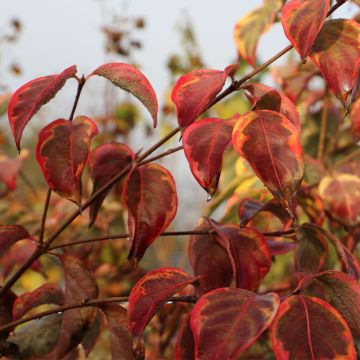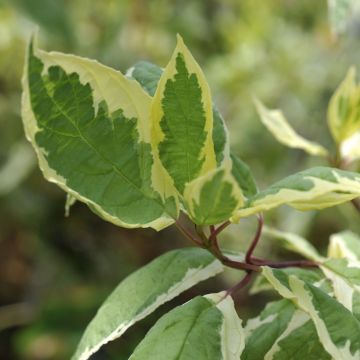

Cornus kousa Pink Lips
Cornus kousa Pink Lips
Cornus kousa Pink Lips
Kousa Dogwood, Korean Dogwood, Chinese Dogwood, Japanese Dogwood
Special offer!
Receive a €20 voucher for any order over €90 (excluding delivery costs, credit notes, and plastic-free options)!
1- Add your favorite plants to your cart.
2- Once you have reached €90, confirm your order (you can even choose the delivery date!).
3- As soon as your order is shipped, you will receive an email containing your voucher code, valid for 3 months (90 days).
Your voucher is unique and can only be used once, for any order with a minimum value of €20, excluding delivery costs.
Can be combined with other current offers, non-divisible and non-refundable.
Why not try an alternative variety in stock?
View all →This plant carries a 24 months recovery warranty
More information
We guarantee the quality of our plants for a full growing cycle, and will replace at our expense any plant that fails to recover under normal climatic and planting conditions.
Would this plant suit my garden?
Set up your Plantfit profile →
Description
Cornus kousa Pink Lips is an amazing flowering Dogwood, whose foliage is as ornamental as its flowers. The delicate and elongated, curiously wavy leaves are stunning in spring when they combine green, white, and pink, giving a very bright aspect to the bush. They gradually turn green as the flowering appears in June, in the form of pink bracts surrounding the true flower. This then evolves into decorative red fruit at the end of summer, while in autumn, the foliage turns pink again, almost purple. An extremely decorative shrub, with attractive colours from spring to autumn. A guaranteed spectacle for three-quarters of the year!
Cornus kousa, native to China, Japan, and Korea, belongs to the Cornaceae family, like Davidia (the handkerchief tree) or Nyssa. There are several dozen species of Dogwoods, most of which are shrubs, but there are also small trees, such as Cornus nuttallii, and undershrubs, such as Cornus canadensis, which forms a ground cover.
'Pink Lips' is a very original cultivar of the Japanese Dogwood, easily recognisable by its atypical foliage. This medium-sized shrub has slow growth and initially has an upright habit, which gradually becomes more rounded. After about ten years in the ground, it will have a bushy habit, reaching a height of about 2m to 2.50m with a spread of 2m. At maturity, it will not exceed 3m in height, which is perfect for small gardens, as well as for planting in flower beds.
Its elongated leaves are narrow, and wave and curve curiously, taking on a wrinkled appearance. Placed opposite each other on the fine branches, their particular morphology gives a tousled aspect to the plant in spring when they emerge and begin to grow. They are variegated in a mix of green and white with pink veins, creating a superb combination of colours with the almost red pink of the young branches. Gradually, they turn green during the season, providing a uniform background for the splendid flowering in June (or July in cold climates). The spherical, greenish flowers would be quite insignificant if they were not surrounded by 4 large bracts, which are transformed leaves resembling petals. They are bright pink slightly veined with white and approximately oval, they form inflorescences 8cm in diameter, highlighted by the green background of the vegetation. This abundant flowering is one of the most beautiful in the plant kingdom, often rightly compared to a flight of butterflies, as it is very airy. In late summer, the flowers develop into small, red fleshy, spherical fruits, carried by a long peduncle, resembling strawberries, and quite decorative. In autumn, the foliage takes centre stage again, turning pink once more, marbled with green, its intensity gradually increasing, almost approaching purplish pink by the end of the season, before finally falling before winter.
This is a shrub for neutral to acidic soil and appreciates humus-bearing, moist to wet but well-drained soils. It is resistant to temperatures as low as -15°C to -20°C, and grows in full sun, but in hot climates, it prefers partial shade, which guarantees better atmospheric humidity.
Cornus kousa 'Pink Lips' requires little maintenance, is particularly resistant to diseases, and due to its limited growth, does not need to be pruned. It just needs to be watered during hot periods to prevent the soil from drying out. It is in partially shaded situations that the luminous character of its variegated foliage will be best highlighted. It will be perfect integrated into an acid soil flower bed, planted in the second layer. At its feet, plant low shrubs such as Andromeda polifolia Compacta, a charming ground cover with very fine dark green foliage, which is covered with small white-pink bells from April to June. Slightly taller Sarcococca Winter Gem is an evergreen undershrub of about 70cm that flowers from January to March, producing small highly fragrant white and pink flowers. To extend the range of summer blooms, go for Hydrangea French Bolero, an extraordinary Hydrangea with a voluptuous tender flowering from June to September. In the background, nothing beats a small tree like Magnolia brooklynensis Yellow Bird, a variety with rather fast growth that will reward you in May, and sometimes also in summer, with beautiful yellow flowers.
Plant habit
Flowering
Foliage
Botanical data
Cornus
kousa
Pink Lips
Cornaceae
Kousa Dogwood, Korean Dogwood, Chinese Dogwood, Japanese Dogwood
Cultivar or hybrid
Other Cornus
View all →Planting and care
Cornus kousa Pink Lips appreciates a soil rich in organic matter, moist but well-drained, with an acidic or neutral tendency. Fairly hardy and able to withstand temperatures down to -15°C, it will still prefer a location sheltered from cold and drying winter winds. Young plants may suffer slightly from frost. It thrives in full sun as well as partial shade, with a preference for the latter exposure, where its variegated foliage will shine. Planting is done in spring or autumn. Soak the root ball in a bucket for a quarter of an hour to thoroughly saturate it. During this time, dig a planting hole 50 or 60 cm on each side and in depth, and mix a bag of planting compost with the existing soil. Place the root ball in the soil, backfill around it, and water thoroughly. Provide regular water supply for the first two years, and during hot periods thereafter.
Planting period
Intended location
Care
Planting & care advice
This item has not been reviewed yet - be the first to leave a review about it.
Similar products
Haven't found what you were looking for?
Hardiness is the lowest winter temperature a plant can endure without suffering serious damage or even dying. However, hardiness is affected by location (a sheltered area, such as a patio), protection (winter cover) and soil type (hardiness is improved by well-drained soil).

Photo Sharing Terms & Conditions
In order to encourage gardeners to interact and share their experiences, Promesse de fleurs offers various media enabling content to be uploaded onto its Site - in particular via the ‘Photo sharing’ module.
The User agrees to refrain from:
- Posting any content that is illegal, prejudicial, insulting, racist, inciteful to hatred, revisionist, contrary to public decency, that infringes on privacy or on the privacy rights of third parties, in particular the publicity rights of persons and goods, intellectual property rights, or the right to privacy.
- Submitting content on behalf of a third party;
- Impersonate the identity of a third party and/or publish any personal information about a third party;
In general, the User undertakes to refrain from any unethical behaviour.
All Content (in particular text, comments, files, images, photos, videos, creative works, etc.), which may be subject to property or intellectual property rights, image or other private rights, shall remain the property of the User, subject to the limited rights granted by the terms of the licence granted by Promesse de fleurs as stated below. Users are at liberty to publish or not to publish such Content on the Site, notably via the ‘Photo Sharing’ facility, and accept that this Content shall be made public and freely accessible, notably on the Internet.
Users further acknowledge, undertake to have ,and guarantee that they hold all necessary rights and permissions to publish such material on the Site, in particular with regard to the legislation in force pertaining to any privacy, property, intellectual property, image, or contractual rights, or rights of any other nature. By publishing such Content on the Site, Users acknowledge accepting full liability as publishers of the Content within the meaning of the law, and grant Promesse de fleurs, free of charge, an inclusive, worldwide licence for the said Content for the entire duration of its publication, including all reproduction, representation, up/downloading, displaying, performing, transmission, and storage rights.
Users also grant permission for their name to be linked to the Content and accept that this link may not always be made available.
By engaging in posting material, Users consent to their Content becoming automatically accessible on the Internet, in particular on other sites and/or blogs and/or web pages of the Promesse de fleurs site, including in particular social pages and the Promesse de fleurs catalogue.
Users may secure the removal of entrusted content free of charge by issuing a simple request via our contact form.
The flowering period indicated on our website applies to countries and regions located in USDA zone 8 (France, the United Kingdom, Ireland, the Netherlands, etc.)
It will vary according to where you live:
- In zones 9 to 10 (Italy, Spain, Greece, etc.), flowering will occur about 2 to 4 weeks earlier.
- In zones 6 to 7 (Germany, Poland, Slovenia, and lower mountainous regions), flowering will be delayed by 2 to 3 weeks.
- In zone 5 (Central Europe, Scandinavia), blooming will be delayed by 3 to 5 weeks.
In temperate climates, pruning of spring-flowering shrubs (forsythia, spireas, etc.) should be done just after flowering.
Pruning of summer-flowering shrubs (Indian Lilac, Perovskia, etc.) can be done in winter or spring.
In cold regions as well as with frost-sensitive plants, avoid pruning too early when severe frosts may still occur.
The planting period indicated on our website applies to countries and regions located in USDA zone 8 (France, United Kingdom, Ireland, Netherlands).
It will vary according to where you live:
- In Mediterranean zones (Marseille, Madrid, Milan, etc.), autumn and winter are the best planting periods.
- In continental zones (Strasbourg, Munich, Vienna, etc.), delay planting by 2 to 3 weeks in spring and bring it forward by 2 to 4 weeks in autumn.
- In mountainous regions (the Alps, Pyrenees, Carpathians, etc.), it is best to plant in late spring (May-June) or late summer (August-September).
The harvesting period indicated on our website applies to countries and regions in USDA zone 8 (France, England, Ireland, the Netherlands).
In colder areas (Scandinavia, Poland, Austria...) fruit and vegetable harvests are likely to be delayed by 3-4 weeks.
In warmer areas (Italy, Spain, Greece, etc.), harvesting will probably take place earlier, depending on weather conditions.
The sowing periods indicated on our website apply to countries and regions within USDA Zone 8 (France, UK, Ireland, Netherlands).
In colder areas (Scandinavia, Poland, Austria...), delay any outdoor sowing by 3-4 weeks, or sow under glass.
In warmer climes (Italy, Spain, Greece, etc.), bring outdoor sowing forward by a few weeks.


































































